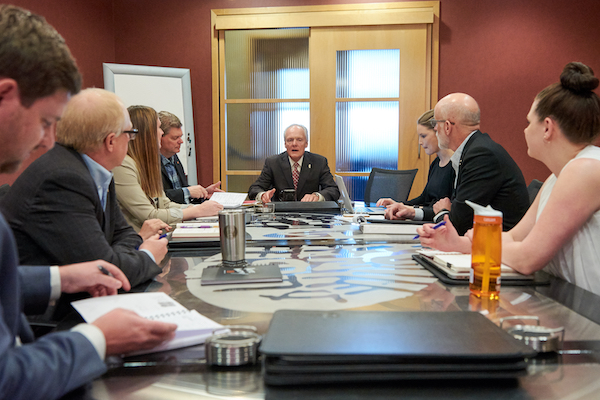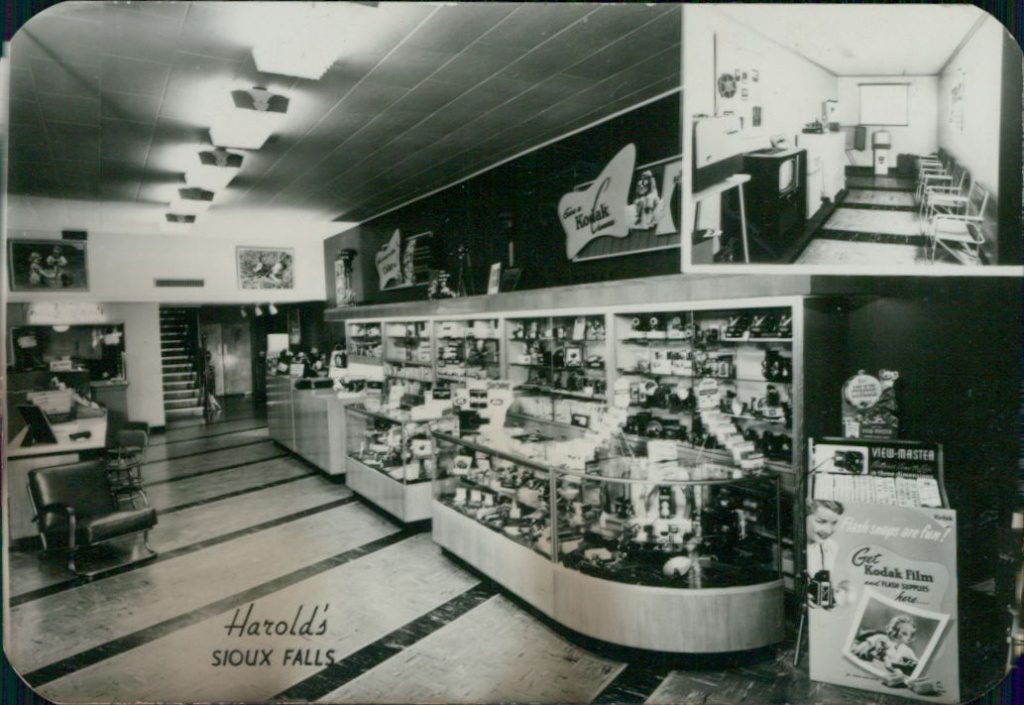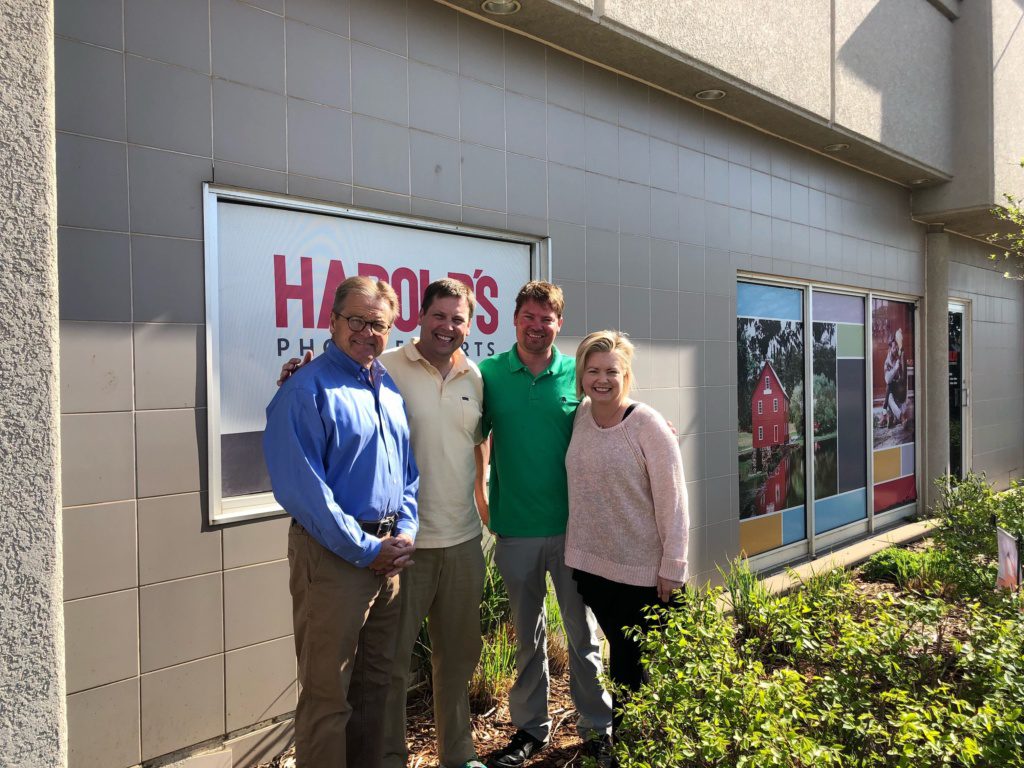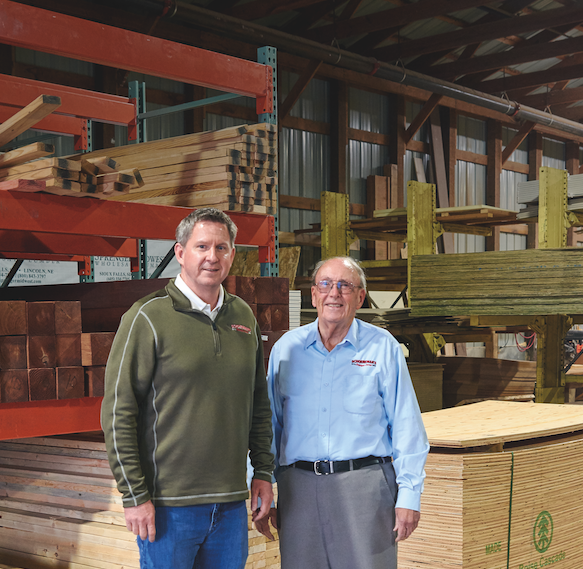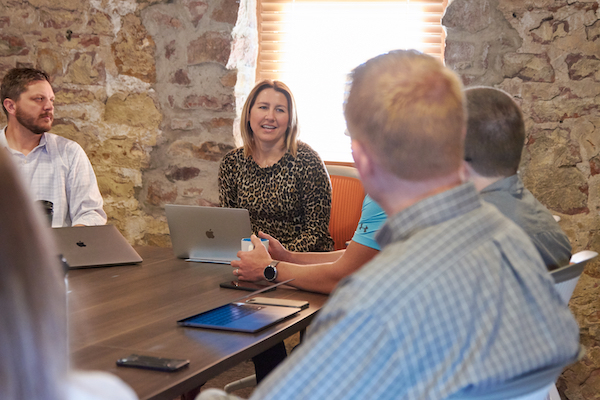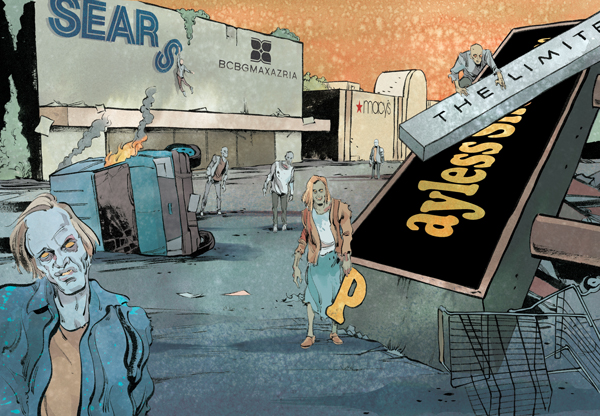Passing the baton: Businesses offer insight on planning, executing leadership transitions
June 10, 2019
This paid piece is sponsored by the Sioux Falls Area Chamber of Commerce.
Scott Lawrence goes to his office at marketing firm Lawrence & Schiller with a hunch and a hope that his successor is in the same building.
Al Schoeneman goes to his office and sits in the same room as his heir apparent, Pat Costello, one of many intentional steps he takes as he transitions his business, Schoeneman’s Building Materials Center.
Across the area business community, countless other organizations are thinking about, in the process of or just on the other side of a transition at the top.
“Two-thirds of my clients right now are in some form of leadership-to-ownership transition, and I’ve probably had close to 40 clients over the last seven years,” said Mike Ridder, owner of Blueprint Business Advisory, who helped guide marketing firm Click Rain, among others, through its CEO search.
“The old guard is starting to change, and some of that old guard has been very visible. So people are more aware of leadership transitions today than they used to be.”
Thinking ahead
In some ways, succession planning has been on Lawrence’s mind since 1999 when he helped write the plan that ultimately led to him becoming the firm’s president in 2002.
A former teacher, he joined the firm in 1984 and after about two years realized he aspired to run the company that his brother Craig Lawrence and Paul Schiller had started.
“So I started positioning myself with Craig and Paul and said I could prove worthy of merit for such an endeavor,” he said.
Fast-forward about 20 years and it’s now Scott Lawrence looking at the firm’s next generation of leaders.
“There’s no family in the company,” he added. “It was set up that we’re not going to have our kids in the company, and I’ve honored that. But we’re kind of a multigeneration non-family business, so succession has on my mind since 1999. It’s a very, very critical topic you cannot expect will come together in quick order.”
He has started the process over the past several years by cultivating his five-person leadership team and three partners.
“People development is every bit as rewarding to me as doing a great ad campaign,” he said.
“You have to build that group and help them see the bigger picture. We’re getting there. Succession is a touchy but rewarding subject, and I have seen too many individuals just think it’s going to happen. I’m working to make sure a succession is as smooth and seamless as possible, so others can have the opportunities I was blessed to have.”
Part of the planning process involves setting a deadline. Lawrence, 62, said he plans to be out of daily operations and into a potential board or advisory role in five years. He just published a book on leadership and anticipates writing more and growing his speaking engagements.
His successor must fit the culture of the 80-person agency, he said.
“Respect is earned and not given,” he said. “We throw fish in the tank and some do well and some don’t survive in the habitat, and that’s the way it is in any business. I could sell to an agency holding company … but that ecosystem we’ve worked so hard for, to have salaries come back to our community and philanthropy, would be gone, and I don’t want to see that happen. I want to see the next generation be able to be part of it.”
Lawrence has growing confidence his successor will be an internal promotion, he said, adding he’s looking for someone who’s innovative, cares about the people he or she manages and is a team builder.
“They need to be upbeat, innovative and calm. I don’t care how chaotic the situation is; if you’re in leadership, you’re going to come in calm and with ideas and help figure it out.”
He plans to vet prospective candidates in the coming years and include his three minority partners as he works through the transition.
“In any succession plan, you have to construct it such that for those that are leaving and those that are coming in, it’s a win-win.”
Industry transition drives plans
Transitioning generational leadership isn’t a new concept for Harold’s Photo Experts, which was founded in 1910 and is on its third generation of leaders.
But when president Bob Hanson thinks about the fourth generation, it’s hard not to feel like forces outside his control will dictate some of whatever course the business takes.
“With this kind of business, it’s crazy what we’ve gone through,” he said. “You’re at the mercy of the industry.”
Harold’s has evolved in many ways since Emil Hanson started it in downtown Sioux Falls as a portrait studio. His sons, Howard and Harold, opened another camera store and portrait studio under the name Harold’s. In the late 1960s, Bob Hanson and his cousins, Tom and Rick, joined the business.
“We never talked about a transition, but like many I worked in the store always,” Hanson said.
“We finally got to the point where it was growing so fast, and the ownership was with Howard and Harold, and it was logical to do a financial agreement where we would start to buy the business from there.”
He bought his father’s share, and his cousins divided their father’s share. With more stock, Hanson became president, though it was three equal owners in terms of decision-making.
Each managed an area: the photofinishing plant, ancillary businesses such as dry cleaning and a travel agency, and the camera stores.
But as regional and national retailers moved into the market, photofinishing was consolidated, and “Kodak and Fuji bought up all the people like us because the business switched from single drugstores to chain drugstores,” Hanson said.
In the early ’90s, they sold the photofinishing business to Fuji, which retained his cousin as a manager, and “it seemed to make the most sense to split up,” Hanson said. “So I bought the camera stores, and Tom and Rick bought the ancillary businesses.”
The camera and photo businesses, though, haven’t stopped changing.
Harold’s once had nine locations. There now are three – Sioux Falls, Fargo and Sioux City – and the fourth generation has a vastly different business landscape to navigate.
“It’s a complete transition,” Hanson said, adding that of similar businesses “there’s hardly any that have survived.”
His three children have taken on roles in the business. His daughter, Emily Erfman, is director of operations, overseeing marketing and IT. His son Davis works on the retail side of the business, and his son Andrew works on the lab side of it, along with running the family’s FastSigns franchise in Sioux City.
Deciding to work for the business “was just kind of natural,” Erfman said. “I went into marketing because we needed help at that time, and I worked under the director of marketing, and Davis gravitated to the stores and Andrew to the lab, but it wasn’t very formal.”
As the business has streamlined, they have taken on more hands-on roles.
“We used to process thousands of rolls of film, and we don’t anymore,” Hanson said. “So before, there was a lot of volume to manage. Now, we do fewer transactions but at larger price points, so the quality is more important.”
Erfman has led the company’s move online, which the family realizes is both key to its future but also a competitive challenge.
“Our website is literally improving by the minute, so we’re making good headway on that,” Erfman said. “And now that we’re back into production, we’re really emphasizing quality.”
A look around also reflects the changing times. The same business that offers photo restoration and converts 8 mm reels and VHS tapes is filled with monitors for self-service and prints photos on everything from acrylic to metal and canvas. There are photo books of all sizes, keepsake items, cards and calendars.
“People never really wanted a camera. They wanted a photograph, a memory,” Hanson said. “They still want that.”
And some still want cameras. While most people’s smartphones can capture the equivalent of a $200 camera, Harold’s inventory now is geared toward higher-end cameras for hobbyists and enthusiasts.
The family is candid when talking about its plans. The immediate focus is on the business model. Transitions and timelines will come eventually.
“It’s a year-by-year thing,” Hanson said, adding that he’s grateful to be navigating his changing business from a market as strong as Sioux Falls.
“Thank God for Sioux Falls and how good it’s been to us,” he said. “The only reason it’s prospered is because of the community. So thank you, Sioux Falls, for being what you are and for allowing our family business to go on for four or five generations.”
Employee ownership, gradual transition
Al Schoeneman still starts every weekday at 5:30 a.m. when he unlocks the door of his store in Harrisburg.
When he arrives at his corporate office, his desk faces his eventual successor, vice president Pat Costello who joined the company in mid-2016.
“I presumed Al would move to the bigger office in the building and mine would be the smaller one,” said Costello, who previously served as commissioner of the Governor’s Office of Economic Development.
“And Al said we’ll office together. It wasn’t what I expected, but we share an office, and the unseen value of that is I hear his calls and we have conversations while we’re both working.”
Schoeneman, who’s the fourth generation to lead his family’s business, knew the value of that approach to a transition.
His father, Cecil, and uncle, Herb, worked in the business into their 90s.
“I was fortunate to have them for 40 or more years, and the three of us worked through it,” Schoeneman said. “There’s no better learning than to be side-by-side.”
Schoeneman began creating the structure for his transition a few years ago when he formed an Employee Stock Ownership Plan, or ESOP.
“I was the only one in my generation in the family business, and having no children myself, you wonder what to do with the company,” he said.
“ESOPs are a way to provide for your employees’ retirement. They accumulate stock and cash out at retirement, and that becomes their retirement fund. It’s far more beneficial than a 401(k). Each ESOP is structured individually, and in our case we structured it so the employees put no dollars in, and it’s all company funded.”
He had entertained selling Schoeneman’s at one point, but the employees worried about how that might affect their future.
“So I pulled the plug on that idea,” he said.
Instead, he created an approach so generous that the attorney who helped structure the deal at first thought he couldn’t have understood correctly.
“Effectively, he’s gifting the company to the employees,” Costello said. “It’s a one-way street. There’s only stock and cash going in. There’s nothing going to Al as the owner. The attorney said he’s worked on hundreds of ESOPs and never seen one as generous as this.”
Schoeneman said it was important that the company survive long past him and be successful into the future and that his employees were taken care of.
“I have other assets, and I don’t have extravagant plans,” he said of the decision to forego profit from selling his company.
Costello was prompted to reach out to Schoeneman after hearing the longtime owner was considering selling the business.
It led to the former GOED commissioner joining the company and buying into the ownership.
“So Al and I and the ESOP are partners,” Costello said. “We have 55 employees, and 49 have ESOP participation. The others are new employees who haven’t been here a year, which is a prerequisite for participation, or part-time employees who are ineligible.”
The two knew one another from decades of living in Sioux Falls and being in the business community. Herb Schoeneman and his wife were frequent guests at Costello’s parents’ home. Costello remembers being given a kids’ nail apron when he went to Schoeneman’s downtown with his father to pick up materials for the family apartment business.
“I hear from people all the time ‘You really found a good one in Pat Costello,’ from people of all walks of life,” Schoeneman said.
Their transition has been gradual and intentional. While Costello arrived with significant business experience, he still needed to learn the lumber industry. He benefits from the experience and expertise of the managers at the company’s four lumberyards and from Schoeneman, who continues to do the majority of the buying for the company.
“We talk, and when it comes to decisions, we pretty much come to the same conclusion without any big debate,” Schoeneman said.
He now spends part of the year in Arizona, while making frequent trips back and handling some business remotely.
They have talked about a leadership transition at the end of 2020, but no one’s locked in on it yet.
“We imagine whatever that time is that Al will always keep an office here,” Costello said.
Executing the plan
As Paul TenHaken approached a decade after founding marketing technology firm Click Rain, he knew it was time for something different.
At the time, he didn’t know that calling would lead him to City Hall, where he became mayor in the spring of 2018.
But he did realize it was time to find the next CEO of the company, which ultimately led to a transition with Natalie Eisenberg, a member of his executive team.
Eisenberg had joined the firm in 2016. When TenHaken shared his desire to move on, “as an executive team, this became an issue we needed to solve, to decide who would be our CEO and who would continue in the leadership team and what the roles would be,” Eisenberg said.
They tapped Ridder of Blueprint Business Advisory to advise them through the process and began holding regular transition meetings outside of their typical leadership team meetings.
“We worked with Mike to set a timeline, figure out what the milestone decisions would be, and one of the first things we did was outline the qualities and characteristics we were looking for in a new CEO,” Eisenberg said.
“Then, we made a short list of candidates in the market, people we knew, and we started to casually vet people, and my name was thrown in the hat at that time.”
Ridder helped facilitate the internal conversations, which always drove back to the characteristics needed in the new leader: someone who could move the company out of startup mode and into its next stage of growth, advance its craft and diversify its offerings, and help it grow connections in the community.
“The one that stuck out was Natalie,” Ridder said. “She wasn’t hired to be the next CEO. She was hired to lead the sales charge, but her talent set and her core values were in alignment with the company.”
It’s a good lesson for other businesses to not discount people for opportunities because they might not come with all the needed skills immediately, he added.
“There are a lot of things that can be coached and trained, but don’t look at the obvious choices as the only choices. Open up the bandwidth a bit. In Natalie’s situation, it was looking at future opportunities and what her skill sets are in general.”
By mid-July 2017, Click Rain’s decision was communicated to employees, and a new leadership structure began to be put in place, aligning each of the firm’s partners with specific areas of oversight.
“Then, it was time to go public,” Eisenberg said. “We met with SiouxFalls.Business to help tell our story, and for a few months, Paul and I intentionally spent time together internally and externally. We golfed together. We went to meetings together. We spent time with him shadowing me at work.”
They also read the book “Traction” by Gino Wickman that introduces the idea of an Entrepreneurial Operating System and used it to help put a more systematic way of managing the company in place.
Once TenHaken sold his share of Click Rain and transitioned out, Eisenberg and the leadership team continued to work with leadership coach Rick Melmer to strengthen their skills and keep focused on their plan.
“I think working with outside advisers to get outside perspective and having a plan and a good system in place for the daily operation was really key for us,” she said. “You want your business to be able to function really well while you’re dealing with the bigger-picture things.”
She’s now moving toward putting her own stamp on the business, emphasizing a culture of being a people-first company.
“We want to be the anti-burnout agency,” she said. “Traditionally, agency life is cutthroat and high-pressure. Being a people-first company applies both internally and to our clients and to our community. We’re a digital company, but we remember there’s always a human on the other end.”
And if your company is approaching the need for a leadership transition, here’s Ridder’s best advice: Start now.
“At a minimum, a really good transition is going to take at least 18 months. Too often, companies don’t give it enough time. Give people the necessary resources to learn and understand what they’re walking into. If we’d just given Natalie the keys and said, ‘Good luck,’ it would be a different scenario than it is today.”


